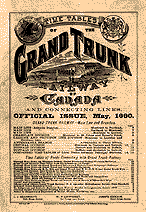





| Click on the icons to have access to the photo collection |
 The Grand Trunk Railway of Canada was proposed in 1851
as the main trunk line through the United Province of Canada. It was formally
incorporated in 1852 to build a railway from Toronto to Montreal. The Grand Trunk Railway of Canada was proposed in 1851
as the main trunk line through the United Province of Canada. It was formally
incorporated in 1852 to build a railway from Toronto to Montreal.At the time, the GTR desired a rail access to Portland, Maine, a seaport that could be used all year long ( the port of Montreal closed each winter). Accordingly, in 1853, the company amalgamated with the St. Lawrence & Atlantic Railroad, acquiring its line between Montreal and the Canada-United States border. It also leased the St. Lawrence & Atlantic Railroad line from the border to Portland. The original track gauge (the distance between the two rails) of this line was 5-foot 6-inches. The GTR adopted this gauge for all their lines but later, in 1873, converted their lines to the "Standard" gauge of four-feet-eight and one half inches. A bridge over the St. Lawrence River to connect this line to Montreal was required. Construction of the Victoria Bridge began in 1854, and the first train operated over it in 1859.  After its formation, the GTR proceeded
immediately with the construction between Montreal and Toronto. This line
was opened for traffic in 1856. During this period, other railway construction
had been undertaken west of Toronto, towards Guelph and Stratford. This
line was extended to Sarnia, in 1859. A ferry service was then established
across the St. Clair River to Fort Gratiot (now Port Huron, Michigan). This
service was later replaced by the St. Clair Tunne, which was opened for
railway traffic in September 1891. After its formation, the GTR proceeded
immediately with the construction between Montreal and Toronto. This line
was opened for traffic in 1856. During this period, other railway construction
had been undertaken west of Toronto, towards Guelph and Stratford. This
line was extended to Sarnia, in 1859. A ferry service was then established
across the St. Clair River to Fort Gratiot (now Port Huron, Michigan). This
service was later replaced by the St. Clair Tunne, which was opened for
railway traffic in September 1891.In Quebec, a line had been built from Quebec City to Richmond between 1848 and 1854. Upon its completion, it was taken over by the GTR, and extended to Rivière-du-Loup to connect with the Intercolonial Railway. In 1864, the GTR took over the Champlain & St. Lawrence Railroad. This was Canada's first railway, and had been completed from Laprairie to St. John's, Quebec in 1836, and extended to Rouses Point, New York in 1851. By 1880, the Grand Trunk Railway system stretched from Chicago, Illinois to the St. Lawrence River at Montreal, and to the Atlantic Ocean at Portland, Maine. By 1923, 125 smaller railway companies had merged into the GTR. To compete with the Canadian Pacific Railway in western Canada, the GTR formed a subsidiary company, the Grand Trunk Pacific Railway in 1914. This railway experienced heavy financial losses and was largely responsible for the bankruptcy of the GTR in 1919. The Federal Government took over the railway that year, placing it under the management of the Canadian National Railways in 1923. |






 

|

|